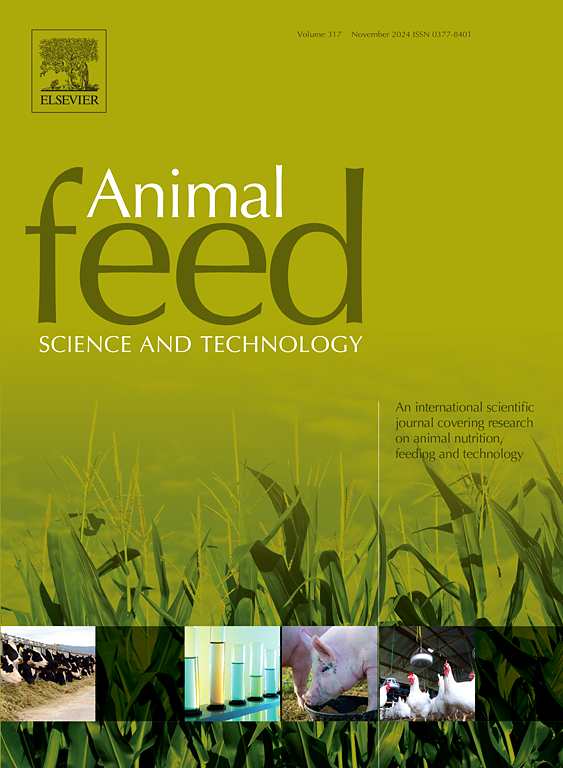Use of an extruded microalgae and flaxseed blend product and its effects on ruminal fermentation and nutrient disappearance
IF 2.5
2区 农林科学
Q1 AGRICULTURE, DAIRY & ANIMAL SCIENCE
引用次数: 0
Abstract
Omega-3 fatty acid supplementation has been researched in both the dairy and beef cattle sectors since these fatty acids are considered essential to animal health. Naturally Better Omega-3 Technologies (Manhattan, Kansas) has developed a supplement consisting of an extruded blend of flaxseed and microalgae (FAB; greatOplus) that is fed to livestock to supplement α-linolenic acid (ALA). Our objective was to evaluate how ruminal microbes alter composition of the fatty acids in the FAB, and their post ruminal disappearance. Eleven steers fitted with ruminal and duodenal cannulas were housed in a facility equipped with the Insentec feed and water monitoring system (Hokofarm, Emmeloord the Netherlands). A cross over design was utilized and treatments included a control diet without ALA supplementation and a treatment diet with supplementation of the FAB at 10 % of the diet dry matter. Duodenal flow of total fatty acids (g) was greater (P=0.002) for cattle supplemented with FAB than for non-supplemented cattle. In particular, duodenal flow of ALA (g) was observed to be four times greater (6.3 g/d vs 1.6 g/d; P=0.001) for steers fed the FAB supplement compared to steers fed the control diet. The inconsistent amount of unsaturated fatty acids consumed compared to the apparent duodenal flow of unsaturated fatty acids, indicates that substantial biohydrogenation of the FAB occurred in the rumen. Supplementing steers with FAB increased the apparent duodenal flow of ALA however, substantial biohydrogenation of the ALA likely occurs and must be taken into consideration when feeding this FAB to increase ALA consumption in cattle.
挤压微藻与亚麻籽混合产品的使用及其对瘤胃发酵和营养物质消失的影响
由于Omega-3脂肪酸被认为对动物健康至关重要,因此已经对乳制品和肉牛部门进行了补充研究。natural Better Omega-3 Technologies(曼哈顿,堪萨斯州)开发了一种补充剂,由亚麻籽和微藻(FAB;用于补充α-亚麻酸(ALA)。我们的目的是评估瘤胃微生物如何改变FAB中脂肪酸的组成,以及它们在瘤胃后的消失。11头安装了瘤胃和十二指肠瘘管的阉牛被安置在一个配备了Insentec饲料和水监测系统的设施中(hoofarm, Emmeloord荷兰)。采用交叉设计,处理包括不添加ALA的对照日粮和添加10% %干物质的FAB的处理日粮。添加FAB的牛十二指肠总脂肪酸流量(g)显著高于未添加FAB的牛(P=0.002)。特别是,十二指肠ALA (g)的流量增加了4倍(6.3 g/d vs 1.6 g/d;P=0.001)。与十二指肠不饱和脂肪酸的明显流动相比,不饱和脂肪酸的消耗量不一致,表明瘤胃中发生了大量的FAB生物氢化。向牛补充FAB增加了十二指肠ALA的表观流量,然而,ALA可能发生大量的生物氢化,在饲喂FAB以增加牛的ALA消耗时必须考虑到这一点。
本文章由计算机程序翻译,如有差异,请以英文原文为准。
求助全文
约1分钟内获得全文
求助全文
来源期刊

Animal Feed Science and Technology
农林科学-奶制品与动物科学
CiteScore
6.00
自引率
6.20%
发文量
266
审稿时长
3 months
期刊介绍:
Animal Feed Science and Technology is a unique journal publishing scientific papers of international interest focusing on animal feeds and their feeding.
Papers describing research on feed for ruminants and non-ruminants, including poultry, horses, companion animals and aquatic animals, are welcome.
The journal covers the following areas:
Nutritive value of feeds (e.g., assessment, improvement)
Methods of conserving and processing feeds that affect their nutritional value
Agronomic and climatic factors influencing the nutritive value of feeds
Utilization of feeds and the improvement of such
Metabolic, production, reproduction and health responses, as well as potential environmental impacts, of diet inputs and feed technologies (e.g., feeds, feed additives, feed components, mycotoxins)
Mathematical models relating directly to animal-feed interactions
Analytical and experimental methods for feed evaluation
Environmental impacts of feed technologies in animal production.
 求助内容:
求助内容: 应助结果提醒方式:
应助结果提醒方式:


